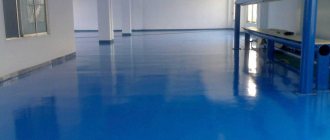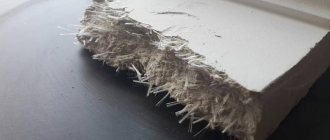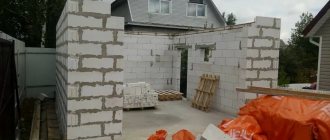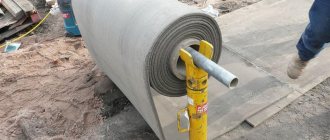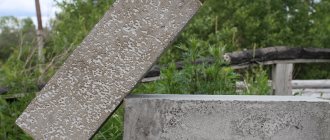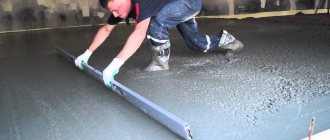On trading floors, concrete paint is presented in a wide range. This applies to brands, prices and compositions. Let's take a closer look at the characteristics of various paints and varnishes, the main advantages and disadvantages of their use. Let us dwell on the basic requirements for materials for painting a mineral surface and its preparation before finishing. After reading the article, it will be easier to decide on paint.
Painting a concrete floor Source prom.st
Characteristics of concrete as a base for painting
The dry residue from a cement-based mortar has high strength and resistance to mechanical stress. The material is characterized by low water absorption and weak adhesion. The surface is usually smooth and dense despite the porous structure.
Surface preparation
When working with concrete paint outdoors and indoors, it is important to ensure intermediate drying. The only exception is the stage of removing solid contaminants, protrusions and weak areas, and old decorative finishes. If there are cracks on the surface, they need to be repaired.
The following actions are aimed at protecting the base:
- Foci of biological damage . Such places must first be cured using means to destroy fungus, mold, bacteria and a brush with running water. Then the dry surface is impregnated over the entire area with antiseptics.
- Traces of rust . They can occur on the surface of metal-reinforced concrete or when hardware is used. Corrosion is removed mechanically and using special liquids. Next, the areas are covered with anti-corrosion primer. Treatment with a solution of copper sulfate (up to 15%) is also acceptable.
Copper sulfate Source kvedomosti.ru
- Soot and grease . They are subject to mandatory removal. There are ready-made tools for this on trading platforms. Or you can dilute about 500 grams. soda ash in a bucket of clean water. Another option is a soap solution.
Painting concrete is not always carried out after filling the pores and leveling the surface with plaster and putty. But it is necessary to work with cracks in any case in order to stop further destruction of the slab. To do this, the area must be saturated with strengthening soil and the depression filled with a repair compound. It is better if it is a cement or polymer based solution.
There is an opinion that the surface must be completely sanded to a smooth state so that flaws in the form of scratches from abrasive are not visible. This statement is partly incorrect, since the painting technology implies better joining with a rough base. You just need to use a medium-grit sandpaper and work in small circular motions without applying too much pressure. Most paintwork materials, when applied in two layers, fill microcracks and hide minor defects.
Concrete grinding Source remontkrovly.ru
The final step at the preparatory stage is treating the surface with a primer. The choice of material is based on the operating conditions of the concrete base (indoors or outdoors, with constant or variable humidity, temperature). It is also necessary to take into account the paint base that will be used for painting. In any case, there must be applicability to mineral surfaces, deep penetration and high adhesion.
Polyurethane
The polyurethane mixture forms a durable and strong base. Materials of this group are effective when painting floors. Concrete paint for interior use on a polyurethane basis forms a wear-resistant, waterproof, dust-proof coating with excellent external characteristics.
Among the polymer groups, it is customary to single out monourethane - a one-component enamel that allows you to obtain a high-quality floor with minimal labor and time costs. The material is recommended to be used for coating surfaces in garages, parking lots, basements, parking lots, that is, in places for various purposes where high chemical and mechanical loads are expected.
Monourethane, application technology
Manufacturers recommend pre-treatment of the concrete base with a mosaic grinder, followed by cleaning from dust and sludge, and priming (PU 555). The master can manipulate a sprayer, a brush or a fur roller. The consumption of monourethane varies from 250 to 500 grams per 1 m² , which depends on the condition of the base surface and the type of concrete.
The composition is applied in two layers on a dry, clean base, on the surface of which there is no lime milk
Overview of the main components of paintwork materials
Materials are classified according to their purpose and composition. It can be a wear-resistant concrete paint for exterior, interior or universal use. The nature of paints and varnishes can be organic or aqueous. Binders and dyes also differ.
For example, the most inexpensive paints are made using drying oil (oil) or alkyd resin. Today they are used less often for concrete than other materials due to their short service life. It's only 1-2 years. And the application is limited to walls, since the strength of the film is low. But there are significantly improved paints with more complex formulations.
Paint Ma-15 Source regmarkets.ru
Acrylic
This concrete paint is suitable for exterior and interior use. Depends on whether the composition is prepared with water or solvents. The former do not emit toxins and are suitable for use in rooms without ventilation. Pigments, as a rule, are of natural origin: dolomite, talc, chalk. Organic materials are applied to facades and road surfaces, as they are highly resistant to stress and frost. But the smell takes a long time to dissipate and the coating takes longer to dry than its aqueous counterpart.
Positive qualities also include elasticity, durability (up to 20 years), moisture resistance and retention of shape and color when exposed to ultraviolet rays. Colors can be rich, and the film is breathable with varying degrees of gloss. Wet cleaning with soapy cleaning products is acceptable. Apply paint in 2 layers. Consumption reaches 200 g/sq.m.
Acrylic enamel Source prom.st
See also: Catalog of stone house projects for which paint was used for finishing
Vinyl
This paint is often compared to acrylic paint, as the resins are similar in nature and characteristics. But the first is inferior in terms of moisture resistance, inertness to acids, vapor permeability and durability (about 7 years). These compounds also have a rich color and form a durable film. Eco-friendly concrete paints are suitable for exterior and interior use.
The relatively low cost is justified not only by lower quality. The paint contains a large amount of solvent. This fact has a negative effect on the drying of the facade in dry or windy weather, since the evaporation of the base occurs too quickly. Shrinkage is also observed, which prevents finishing of an already painted surface. But a thick layer of material allows you to avoid secondary application. The film forms within two hours. Consumption averages 130 g/sq.m.
Vinyl paint Source pinimg.com
Latex
It is worth noting that synthetic latex can be presented in the form of an aqueous dispersion with styrene-butadiene, polyvinyl acetate, acrylate or urethane copolymer. That is, in essence, acrylic paint is a subtype of the group of latex paints and varnishes. But materials on trading platforms are considered as different compositions.
The general characteristics of the material come down to versatility, that is, you can paint the facade and the children's room. The coating breathes, dries quickly, does not allow moisture to pass through, can withstand cleaning, does not smell, and does not contain metals or toxins. Pigmented compositions remain rich for a long time. The film is elastic and can have different degrees of gloss. Apply in 2-3 layers. The average consumption is 180 g/sq.m.
Latex paint Source skidka-kazan.ru
Polyurethane
The main component is a petroleum refining product. Paintwork materials with elastomers are manufactured as independent compositions and for mixing with a hardener for interior and exterior work in the presence of a canopy. This is due to long drying (up to 14 days). The film for a single-layer coating is 1 mm, which is enough to fill minor defects in the base. Wear-resistant paint for concrete is highly resistant to mechanical stress and water. But under the influence of the sun it fades.
Working with polyurethane paint has its own characteristics. Thus, adhesion to concrete can be improved by treating the base with diluted paint. To do this, add 15% of the total mass of epoxy primer to the composition. And between the layers a little quartz is poured with a fraction of up to 0.3 mm. Consumption is 200 g/sq.m. It is important to monitor the shelf life of packaged paint, which may be limited to six months. The service life can exceed 10 years.
Alkyd-polyurethane paint Source megastroy.com
See also: Catalog of companies that specialize in paints and finishing materials
There is an option for manufacturing polymer paint such as a self-leveling floor using polyurethane. This is a liquid composition that meets high requirements in terms of strength, wear resistance and water resistance. The coating can be single-layer, as the thickness can reach 8 mm. In this case, cracks up to 2 mm wide are filled, differences in the plane up to 4 mm high by 3 meters are covered. Clean tools with acetone, solvent or xylene.
Silicate
Potassium liquid glass is used in the production of this mineral paint. Dyes can be metal oxides or alkali-resistant components. The material has high adhesion to concrete, vapor permeability, strength and resistance to high temperatures. The coating is smooth and protects the surface from corrosion and bacteria and mold.
Silicate paint Source stpulscen.ru
Among other things, the color saturation can be any. No fading occurs under sun exposure. But the paint is not plastic, which makes it difficult to paint over unsmooth concrete with cracks. The composition must be applied to cleaned concrete, since the compatibility of paints and varnishes with analogues is practically non-existent. Indoor use is not recommended due to the content of zinc and other metals. The coating lasts for about 20 years. Consumption reaches 250 g/sq.m. The second layer is applied a day later, it dries for almost 10 hours.
Rubber
The paint consists of water (5%), the rest is acrylate latex and additives. As a result, the covering material has high adhesion and elasticity, vapor permeability, resistance to different temperatures, humidity, and mechanical stress. When wet, the coating does not slip, which explains the use of wear-resistant paint on concrete for exterior work and floors inside the building.
Rubber paint Source obetone.ru
Video description
You can clearly see the rubber coating from the video:
Epoxy
Waterproofing paint for concrete floors can be cold or hot cure, two-component, powder or aerosol. Additions include acrylic or phenolic resin, quartz or glass in the form of dust. They have a positive effect on resistance to ultraviolet radiation and mechanical stress.
The composition is used for painting concrete outside or inside a building, in utility rooms and medical institutions. Self-leveling floors are also coated with epoxy paint to impart rigidity and hardness to the surface. The coating protects the base from corrosion, moisture, biological and mechanical damage. You can clean using any detergents. Apply the composition in 2-3 layers with intermediate drying for up to 24 hours. Consumption is on average 250 g/sq.m. The service life can be 20 years.
Epoxy paint Source purplemint.ru
Classification of coatings by purpose
You can often find an inscription on the packaging that states the versatility of the paint. This can mean 3 different contents. Either we are talking about the base being processed (concrete, wood, glass), or about applicability for work inside and outside the building, or for painting walls, ceilings and floors. Therefore, when choosing one or another composition of paints and varnishes, you must read the detailed instructions.
Let's consider the basic requirements for concrete paint depending on the object being painted:
- Floor . Due to constant or periodic loads on the base, materials must have high strength, resistance to abrasion and wet cleaning. These criteria are met by compositions with acrylic, polyurethane, alkyd or epoxy resin, and liquid glass.
- Foundation . To the list of paints for concrete floors, you can add silicone, which perfectly protects the porous base. What is important here is inertness to weather conditions, mold bacteria and elasticity.
- Road surface and paving slabs . On the street, extreme conditions with changes in temperature and humidity are added to the mechanical load. Alkyd, polyurethane and rubber paints cope with this.
Painted path made of concrete slabs Source pinimg.com
Features of rubber paint
This material is environmentally friendly and is considered safe for the body, since it is based on acrylate additives in a water-dispersion solution. To give different shades, pigment dyes are added to the rubber composition.
Among the nuances of application, the following can be noted:
- The material spreads over the concrete, forming a polymer film.
- Hardening of the coating occurs quite quickly - within 20-30 minutes.
- The composition can be used as facade paint and for painting floors.
Due to the fact that the temperature range for rubber paint is -50...+60°C, it is often used to treat the external surfaces of large structures. In addition, the leveling coating can be applied to outdoor extensions, for example, to decorate the porch of a house or paint an open balcony.
Rubber paint meets all the requirements for similar materials. It is frost and moisture resistant, has a durable, integral top layer, evens out uneven concrete and gives the building a finished look.
Rubber paint has a pleasant texture, indistinguishable from ordinary rubber.
Dyeing technology
There are three ways to add color to concrete structures. The most durable option is pigmentation of the solution at the stage of its preparation. In this case, subsequent updating of the finish will not be required, since the appearance will remain unchanged under the influence of the sun or walking.
Solid coloring of concrete Source synrgi.dk
Another technology is called deep. Here, the components of the paints used enter into a chemical reaction with the substances contained in the concrete. The result is a single surface that is resistant to dirt, moisture and abrasives. The process is complex and expensive, but is justified by its durability.
The third option is the classic application of paint, which forms a protective film. Otherwise, the technology is called surface technology. The result is inferior in strength and service life to the other two, but costs less, the choice of materials is richer and implementation is simpler.
Acidic
Materials of this group allow you to obtain a rich natural surface with a durable and wear-resistant coating. The material is successfully used to paint various paths, paving slabs, platforms, concrete steps, etc.
Only acidic varieties help achieve the amazingly beautiful effect of an “aged surface” or a complete imitation of natural stone.
Acid dye is applied to vertical or horizontal structures using a roller or sprayer and rubbed into the surface in an 8-shaped motion, for which a special brush is used. Rubbing continues until the material stops hissing.
Briefly about the main thing
Paint for concrete can be universal, for work outdoors or at home, for floors, walls, ceilings, facades, foundations and road surfaces.
Thinners for materials can be water or organic compounds, products of the petroleum industry.
Natural or synthetic latex, acrylic, alkyd, vinyl, phenolic or epoxy resin, polyurethane and liquid glass can be used as a base.
There are three types of concrete coloring technology: superficial, deep, and with the addition of dye at the stage of preparing the cement mortar.
